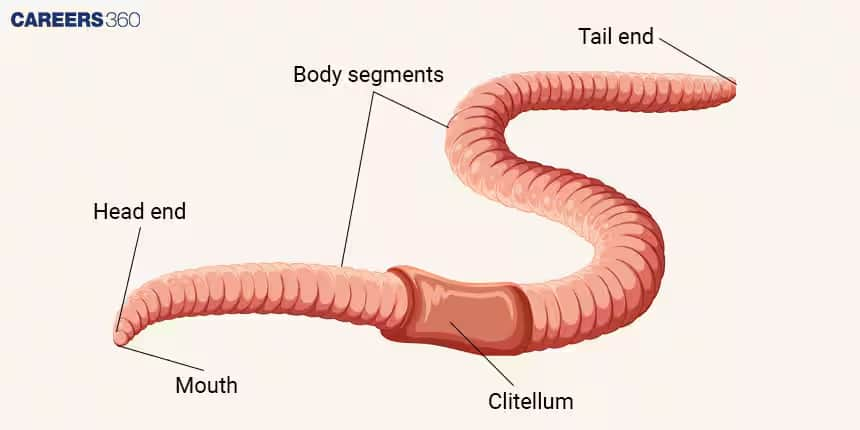Earthworm Scientific Name: Classification, Morphology, Anatomy, Types
Earthworms are tiny invertebrates that have soil as their habitat and are susceptible to pH, waterlogging, and organic matter. These attributes are considered good biological indicators of soil health. Earthworms play an important role in improving soil fertility by helping to loosen up the soil and increasing the nutrient content through their waste. They have a streamlined body and have no limbs.
This Story also Contains
- What are Earthworms?
- Scientific Classification of Earthworm
- Types of Earthworms
- Habitat And Distribution
.jpg)
In almost all types of soil in the world, earthworms are present in conditions that are suitable for them, i.e., areas with sufficient moisture and organic content to support them. They breathe through their skin and feed on organic matter in the soil. As they have numerous benefits towards agriculture, they are also called “farmers’ friends”. Earthworm is a topic of the chapter Animal Kingdom in Biology.
What are Earthworms?
This group of worms, commonly known as “ecosystem engineers”, are a vital component in supporting Earth’s ecosystems and soils. It also points out that some of these invertebrates dig through the soil and are effective in increasing the structure, aeration, and water-holding capacity of the soil. Thus, the soil is enriched by organic matter as earthworms decompose it and recycle nutrients that lead to the growth of healthy plants. They are also very instrumental in supporting productivity in agriculture and the ecosystem, hence showing how they support health in the soil and the environment.
Also Read-
Scientific Classification of Earthworm
The earthworm belongs to the phylum Annelida and is commonly known for its segmented body. Its scientific name varies with species, but a well-known example is Lumbricus terrestris.
Taxonomy
| Kingdom | Animalia |
| Phylum | Annelida |
| Class | Clitellata |
| Order | Opisthopora |
| Family | Lumbricidae |
| Genus | Lumbricus |
| Species | Lumbricus terrestris |
Earthworm Scientific Name- Lumbricus terrestris
Types of Earthworms
Earthworms can be categorised based on their habitat, feeding behaviour, and burrowing activity. Earthworms play various roles in soil aeration, composting, and nutrient cycling. The three main types of earthworm, based on their habitat and ecological role, are:
1. Epigeic Earthworms:
They live near or on the soil surface
They feed on decomposing organic matter, like plant and animal matter.
They are small in size and dark in colour.
Example- Eisenia fetida (commonly used in vermicomposting).
2. Endogeic Earthworms:
They inhabit the upper layers of the soil.
They create horizontal burrows and feed on soil that is rich in organic matter.
They are lighter in colour and medium-sized.
They are mainly bottom dwellers.
Example- Aporrectodea caliginosa
3. Anecic Earthworms:
They make deep, vertical burrows in the soil.
They come to the surface to feed on plant materials.
They are larger and dark in colour.
Example: Lumbricus terrestris.
Habitat And Distribution
Earthworms are typically found in moist, rich soils with plenty of organic matter. They are widely distributed across the world, especially in temperate and tropical regions where soil conditions are favourable for their survival. The habitat and distribution are described below-
Natural Habitat
Most earthworms live within a soil matrix, and they help in the aeration and decomposition of soil nutrients. They prefer habitats which have a good water supply and well-aerated and comparatively fertile soils, such as the loamy or silty soils. Earthworms are distributed all over the world, both in the tropical and temperate regions, but there are some restraints in the type of soil, climate and human influence.
Adaptations
Earthworms are highly active in burrowing, in which they dig numerous tunnels that help to aerate the soil and facilitate plant root systems. These are invertebrates which have thin skin since they breathe through their skin, and this skin must always be wet. To keep the specialised moisture ranges, earthworms reside in greater concentrations of the soil profile or the earth’s surface that has access to an adequate amount of decaying organic debris and moisture.
Also Read-
Frequently Asked Questions (FAQs)
Casts are made up of soil materials and particles of vegetable mould that earthworms ingest from the soil including dead leaves and decomposing plant matter. They also eat soil, which goes through their body and comes out as small black balls called “casts. ”
Earthworms form an essential component of soil health because they make burrows in the soil which help in opening the structure of the soil, thus assisting in root growth.
They are also involved in the breakup of organic substrates dropping out their nutrient-holding particles in the form of castings which improves soil fertility. They enhance nutrient status in the soil for plants and also enhance water stagnation in the soil.
Earthworms play a very important role in composting since they help break the organic waste materials and speed up the process of decomposition. They digest the organic matter and leave a casting which enhances the nutrient content in compost.
Earthworms play the following functions in compost production Due to the earthworm activity, microbial ratings rise hence increasing the quality and fertility of compost.
